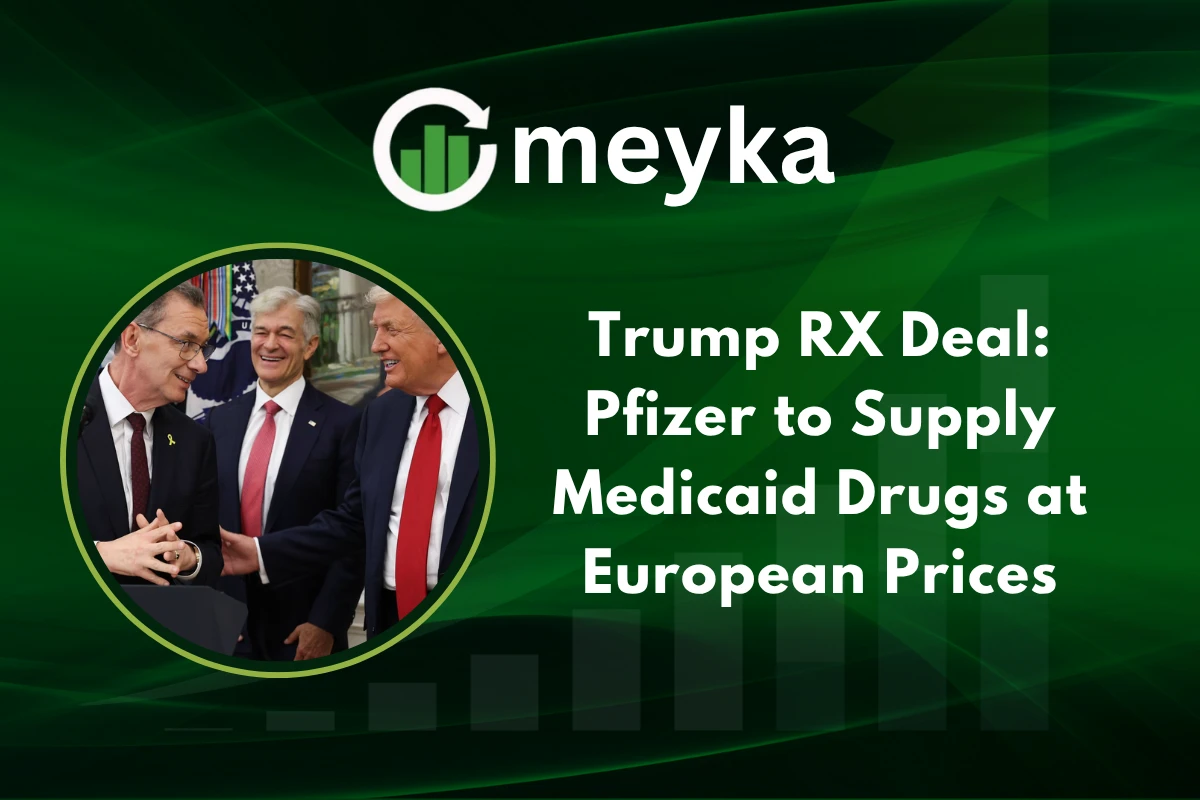Trump RX Deal: Pfizer to Supply Medicaid Drugs at European Prices
A major move landed in Washington this week: under a plan branded Trump RX, Pfizer agreed to sell many drugs to Medicaid at prices similar to those paid in other developed countries. The White House framed the deal as a win for patients and a blow at high U.S. drug prices, while Pfizer said the deal came with manufacturing and investment commitments.
The announcement shifts the drug pricing debate, but leaves key questions about scope, sustainability, and wider market effects.
Trump RX: What the Deal Means for Americans
Under the headline deal, Pfizer will offer many of its medicines for Medicaid at prices that mirror the lowest rates paid in a group of developed countries, after accounting for fees and rebates.
The company said the discounts will apply to a large swathe of primary care medicines and some specialty brands, with savings on average around 50% and in some cases as high as 85% for Medicaid purchasers. The administration also announced plans for a direct-to-consumer site, TrumpRx, to launch in 2026.
Why is Trump RX being introduced now?
The deal arrives amid political pressure to tackle U.S. drug costs and as the White House seeks a high-profile domestic achievement. Policymakers have long highlighted that Americans often pay far more than patients in other wealthy countries.
The administration paired the pricing concession with tariff threats on drug imports and a push for onshore manufacturing, a package pitched as both pressure and incentive to drugmakers.
Pfizer’s Role in the Trump RX Deal
Pfizer became the first major company to sign on publicly. In exchange for the pricing commitment, Reuters reported that Pfizer agreed to a substantial investment plan, including billions aimed at U.S. manufacturing and research, and won a three-year grace period from the administration’s targeted tariffs, provided production shifts are made.
Pfizer’s shares rose after the announcement, showing investor relief that the concessions were confined largely to Medicaid rather than broader commercial markets.
Why is Pfizer agreeing to this now?
Pfizer gains regulatory certainty and a carve-out from looming tariffs while burnishing its public image on affordability. The company also secures a clear roadmap for market access on new launches in exchange for pricing commitments. That trade-off matters for corporate planning and investor sentiment.
How Much Could Americans Save Under Trump RX?
Administration and company materials pointed to significant savings for Medicaid clients: Reuters and other reports cite average savings near 50% for covered medicines, with some medicines seeing much larger reductions.
But the direct impact on overall U.S. drug spending is likely limited because Medicaid is just one payer; Medicare, commercial insurers, and cash-paying patients are outside this specific deal.
Analysts note that Medicaid’s lower spending means the headline savings may matter most to low-income patients but less so to total national drug bills.
Political and Public Reactions to Trump RX
Reactions split along familiar lines. Supporters hailed the move as a concrete step to lower prices and boost domestic manufacturing. Critics warned that the agreement is narrow, focused on Medicaid, not Medicare or commercial markets, and questioned whether discounts will be sustained or replicated by other firms. Observers also flagged the political timing and the potential for industry lobbying to shape future details. Media outlets underscored the deal’s drama while asking whether it changes long-term pricing dynamics
What are critics saying about Trump RX?
Critics worry the deal is limited in scope, may shift costs or prices elsewhere, and could leave senior citizens on Medicare still exposed to high costs. Some healthcare experts also caution that one-off discounts don’t rewrite structural incentives in U.S. drug pricing.
Global Implications of the Trump RX Agreement
If drugmakers adopt similar pricing for Medicaid, it could ripple into international pricing strategies. Some countries already peg prices to each other; U.S. alignment with lower European prices may prompt manufacturers to revisit launch prices and rebate tactics.
However, the deal’s focus on Medicaid limits immediate global shock; what matters more is whether the move becomes a template for broader payer negotiations or regulatory changes.
Could Trump RX push other companies to follow?
Reuters and other reporting suggested drugmakers are watching closely. While Pfizer was first, other firms could offer similar, more limited concessions if they secure comparable trade-offs or carve-outs, especially if tariffs or political pressure remain in play.
Market moves in the days after the announcement showed investors betting that a few rivals might reach similar deals.
What Are the Limits and Next Steps?
Important constraints remain. The deal applies to Medicaid, not Medicare (which covers older Americans and accounts for larger drug spending), and the advertised direct-to-consumer site, Trump Rx, is set to launch next year.
The administration set a three-year grace period tied to Pfizer’s manufacturing commitments, and officials said they expect new Medicaid prices to roll out in 2026. Lawmakers, regulators, and state Medicaid programs will now parse the details and work through implementation.
Conclusion:Trump RX’s Promise and Puzzle
Trump RX is a headline-grabbing step: it demonstrates that big pharma can cut prices for a large public program in return for policy concessions and investment promises. For Medicaid patients on those medicines, the changes could be life-changing.
Yet the deal is narrow in scope and leaves open the harder questions about Medicare, commercial insurance, and the structural drivers of U.S. drug costs. Whether Trump RX becomes a turning point or a one-off depends on follow-on deals, regulatory follow-through, and whether the model expands beyond Medicaid.
For now, the agreement is both a policy experiment and a political statement, one that will be watched closely at home and abroad.
FAQ’S
Trump RX is a new deal announced by Donald Trump under which Pfizer will supply Medicaid drugs in the U.S. at European prices to lower prescription costs.
Medicaid patients could save up to 50% on common prescription drugs, making essential treatments more affordable for low-income families.
Pfizer agreed to join Trump RX to strengthen its public image, gain political goodwill, and expand its Medicaid customer base while facing global pressure on drug prices.
No, Trump RX currently focuses on Medicaid beneficiaries, but analysts say it could pressure other pharmaceutical companies to align U.S. drug costs with European levels.
Yes, if the U.S. adopts European-style pricing, it may encourage other countries to push for stricter pharmaceutical price negotiations worldwide.
Disclaimer
This content is made for learning only. It is not meant to give financial advice. Always check the facts yourself. Financial decisions need detailed research.






